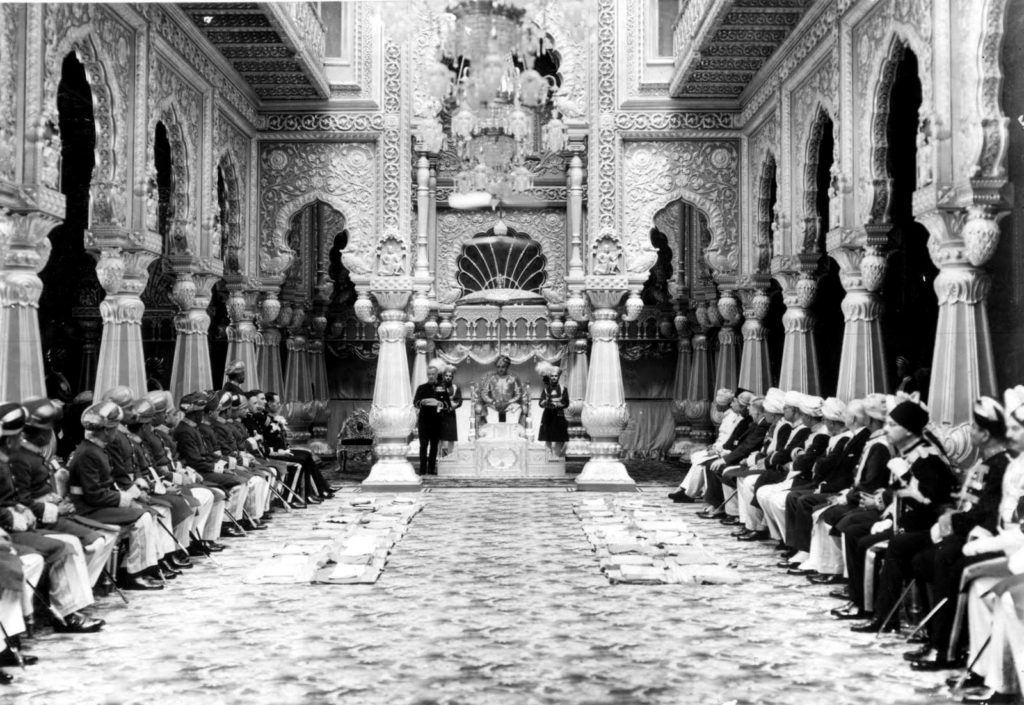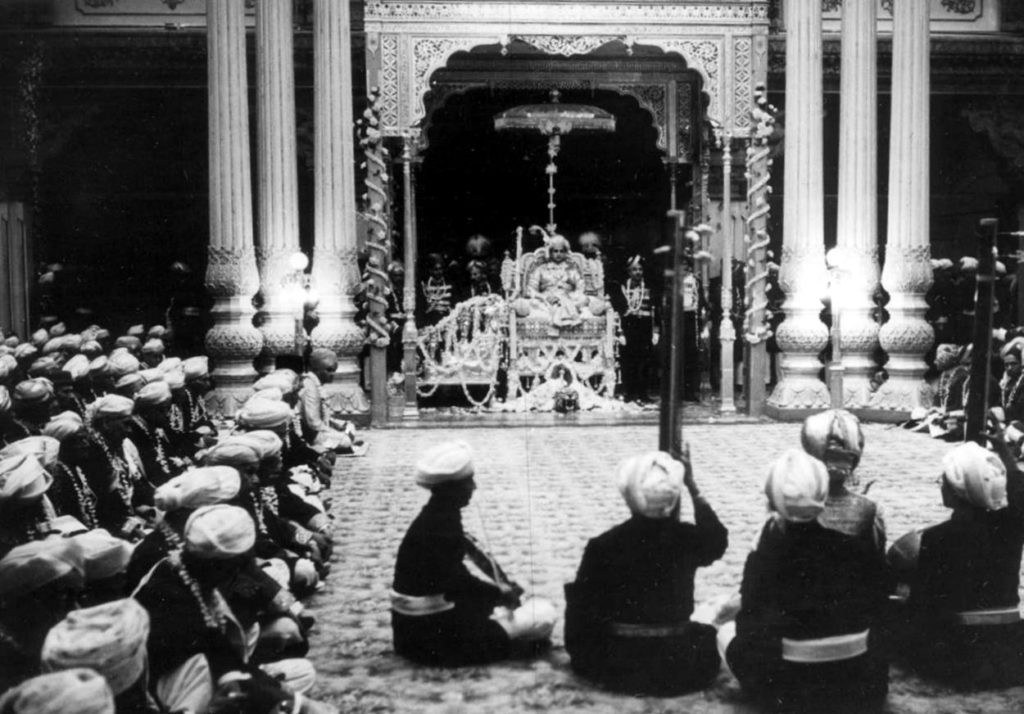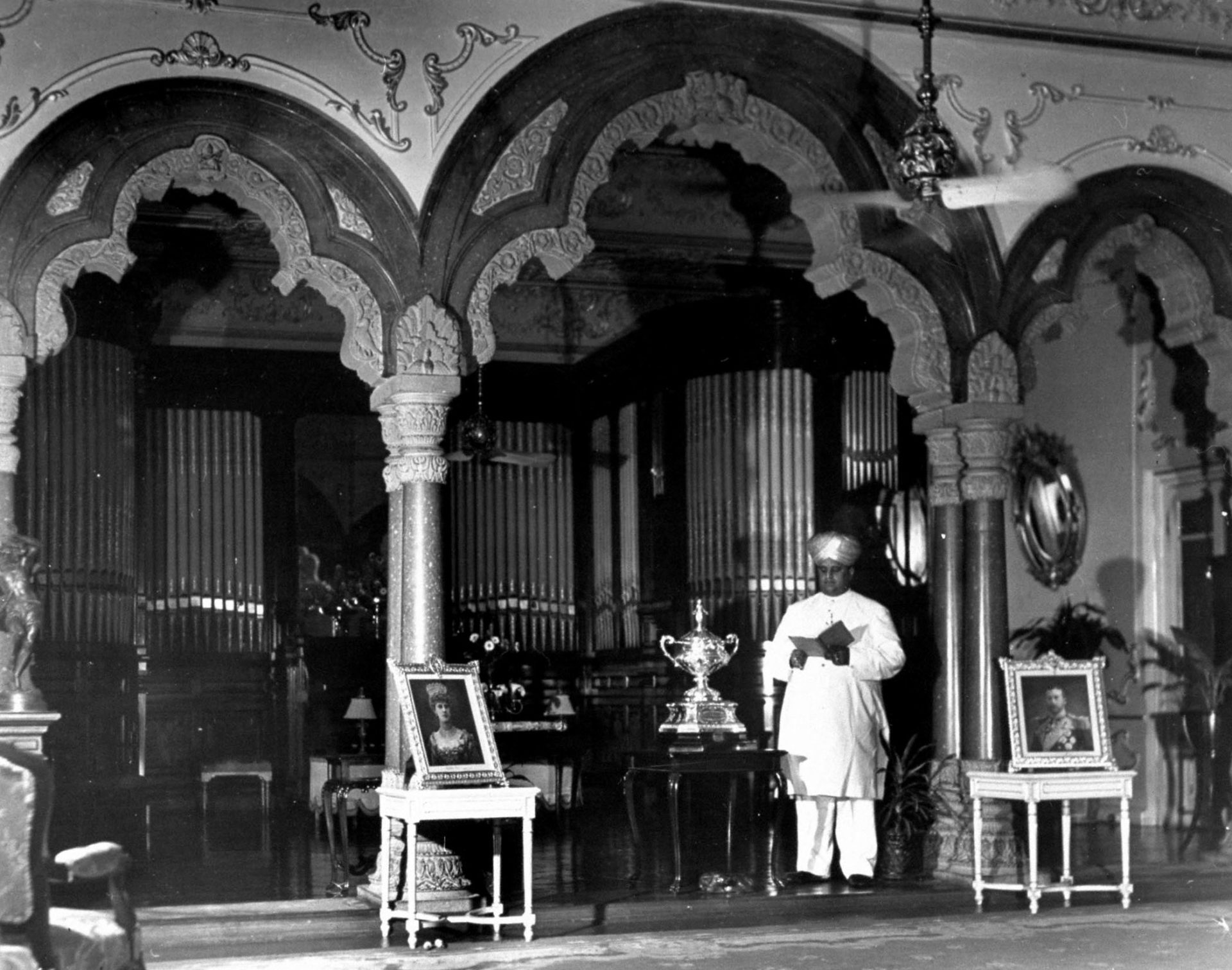 My grandfather, H.H Dr. Jaya Chamaraja Wadiyar Bahadur, was born on July 18, 1919. In keeping with the family tradition, he was named after his revered grandfather, H.H Chamaraja Wadiyar X, with the Sanskrit word ‘Jaya’, or ‘Victory’ in English, prefixed to the name in celebration of his birth coinciding with the end of the First World War and the victory of the allied forces.The Young Prince’s musical journey started at a very young age. His Younger Sister Princess Vijaya Devi revealed that the Prince, and all his sisters, were exposed to Carnatic Classical and Western Classical music from a very young age. The cultural ethos of The Palace, Mysore, was such that all functions, whether informal or formal, always involved some music and that this had a profound influence on the Young Prince. Even though Carnatic Music and Dance was given the utmost prominence at The Palace, Prince Jaya Chamaraja Wadiyar would be inducted into learning music via the piano. Sister Ignatius, a very good pianist and extremely strict teacher, was tasked with ensuring the Prince was well versed in his Musical Studies. His musical genius flowered under her and his talent was made evident at a very early stage. During his Piano examination, his Examiner Dr. Adolph Mann, was so impressed that he went over to his Piano and played ‘See, the conqu’ring hero comes!’ from the oratorio, Judas Maccabaeus, by the famed composer George Frideric Handel, acknowledging the Princes immaculate performance. Prince Jaya Chamaraja Wadiyar’s father, The Yuvaraja H.H Kanteerava Narasimharaja Wadiyar, a jazz aficionado himself, often introduced Prince Jaya Chamaraja Wadiyar and Princess Vijaya Devi, as his ‘two highbrow children’.
My grandfather, H.H Dr. Jaya Chamaraja Wadiyar Bahadur, was born on July 18, 1919. In keeping with the family tradition, he was named after his revered grandfather, H.H Chamaraja Wadiyar X, with the Sanskrit word ‘Jaya’, or ‘Victory’ in English, prefixed to the name in celebration of his birth coinciding with the end of the First World War and the victory of the allied forces.The Young Prince’s musical journey started at a very young age. His Younger Sister Princess Vijaya Devi revealed that the Prince, and all his sisters, were exposed to Carnatic Classical and Western Classical music from a very young age. The cultural ethos of The Palace, Mysore, was such that all functions, whether informal or formal, always involved some music and that this had a profound influence on the Young Prince. Even though Carnatic Music and Dance was given the utmost prominence at The Palace, Prince Jaya Chamaraja Wadiyar would be inducted into learning music via the piano. Sister Ignatius, a very good pianist and extremely strict teacher, was tasked with ensuring the Prince was well versed in his Musical Studies. His musical genius flowered under her and his talent was made evident at a very early stage. During his Piano examination, his Examiner Dr. Adolph Mann, was so impressed that he went over to his Piano and played ‘See, the conqu’ring hero comes!’ from the oratorio, Judas Maccabaeus, by the famed composer George Frideric Handel, acknowledging the Princes immaculate performance. Prince Jaya Chamaraja Wadiyar’s father, The Yuvaraja H.H Kanteerava Narasimharaja Wadiyar, a jazz aficionado himself, often introduced Prince Jaya Chamaraja Wadiyar and Princess Vijaya Devi, as his ‘two highbrow children’.
Tragedy would strike in 1940, first with the passing of The Prince’s father in March and then his Uncle, The Maharaja, H.H (Nalwadi) Krishnaraja Wadiyar IV, in June, leaving him with the tremendous task of ruling the most advanced state in all of India at the young age of just twenty-one years. The Pattabhisheka, or formal anointment, was conducted on the 8th of September 1940, at The Palace and His Highness Sri Jaya Chamaraja Wadiyar Bahadur, Maharaja of Mysore, took up the tremendous responsibility of his forefathers.
Had His Highness’s destiny not been to succeed to the mantle of his forefathers, H.H would have certainly pursued his passion of becoming a concert pianist. When on tour with his father, The Yuvaraja, across Europe, Prince Jaya Chamaraja Wadiyar would visit the acclaimed composer and virtuoso pianist, Sergei Rachmaninoff, in Switzerland in hopes of being accepted as an apprentice. Sadly, all hopes of being involved in music professionally had to be brought to a halt with his ascension to the Mysore Gaddi. However, he still pursued his music studies in addition to his immense responsibility as Maharaja of Mysore, and in 1945, received Licentiateship in Piano performance by the Guildhall School of Music & Drama and was granted an Honorary Fellowship of Trinity College.
After the Second World War, Europe was still limping back to normalcy, and as such funding for composers and ensuring their works were recorded was an enormous challenge. Maharaja Jaya Chamaraja Wadiyar would play a vital role in ensuring several famed composer’s works would see the light of day. One such personality, who was little known to the world, was the Russian composer, Nicolai Medtner. The Maharaja would finance the recordings of Medtner for HMV, thus ensuring that the compositions would get the fame that they deserved. The music critic, Fred Smith would remark about the recording as “one of the greatest romances in the history of the Gramophone” and that “for a reclusive composer living a quiet life in London, it was wonderful that destiny should have brought Medtner’s genius within the spheres of vision and great musical appreciation of H.H The Maharaja Of Mysore.” He adds, “….I shall not forget the look of wonder in Medtner’s countenance as Captain Binstead, Commissioner of H.H The Maharaja, in my presence, put the proposal to him. What a service has been rendered to music….” Medtner for his part dedicated his Third Piano Concerto to the Maharaja in appreciation of his contribution. The Maharaja was so happy with the recordings and the music that he would go on to form the Medtner Society in 1949, that continued to spread awareness about the composer’s work. Thus, it was H.H The Maharaja who played an instrumental role in ensuring that Medtner received his due recognition in the later years of his life. Medtner and The Maharaja would never meet.
 The Maharaja’s involvement in ensuring important compositions were given their due didn’t stop there. Another famed composer, Richard Strauss, who after the Second World War had escaped his homeland Germany and settled in Switzerland at the old age of 84, would write a farewell composition, “Four Last songs”. They were namely, ‘Frühling (Spring), ‘September’, ‘Biem Schlafengehen’ (When falling asleep), and lastly ‘Im Abendrot’ (At Sunset). Strauss’s last wish was for the composition to be sung by the Wagnerian Soprano, Kirsten Flagstad, which he expressed in a letter to her. He would pass away soon after, his last wish unfulfilled. It was H.H The Maharaja that would ensure that Richard Strauss’s last wish come true. H.H would offer a princely sum of $5000 at the time, that would guarantee the performance by the Philharmonia Orchestra, conducted by Wilhelm Furtwängler, with the soprano by Flagstad, as wished by the late composer.
The Maharaja’s involvement in ensuring important compositions were given their due didn’t stop there. Another famed composer, Richard Strauss, who after the Second World War had escaped his homeland Germany and settled in Switzerland at the old age of 84, would write a farewell composition, “Four Last songs”. They were namely, ‘Frühling (Spring), ‘September’, ‘Biem Schlafengehen’ (When falling asleep), and lastly ‘Im Abendrot’ (At Sunset). Strauss’s last wish was for the composition to be sung by the Wagnerian Soprano, Kirsten Flagstad, which he expressed in a letter to her. He would pass away soon after, his last wish unfulfilled. It was H.H The Maharaja that would ensure that Richard Strauss’s last wish come true. H.H would offer a princely sum of $5000 at the time, that would guarantee the performance by the Philharmonia Orchestra, conducted by Wilhelm Furtwängler, with the soprano by Flagstad, as wished by the late composer.
The Maharaja was also the first president of the Philharmonia Concert Society in London in 1948. In this regard the Maharaja had given 10,000 pounds to setup the Society and ensure that Orchestra and the Society were held up on firm basis. Harry Walter Legge, an English Classical Music Producer remarked on his visit to Mysore, “”The visit to Mysore was a fantastic experience. The Maharajah was a young man, not yet thirty. In one of his palaces he had a record library containing every imaginable recordings of serious music, a large range of loud speakers, and several concert grand pianos….”. This funding proved sufficient to transform Legge’s fortunes in 1949. He was able to engage Herbert Von Karanjan as conductor. The repertory the young Maharajah wished to sponsor were Balakriev’s Symphony, Roussel’s Fourth Symphony, Busoni’s Indian Fantasy and others. Legge remarked on the Maharaja’s Contribution in 1950, “….Many more correspondents have written expressing their admiration for the vision, constructive enterprise and generosity of the young Indian Prince who conceived this plan, and who is making it possible for the music lovers throughout the world to learn, enjoy and study works which but for his knowledge and love of music, would never have been recorded…..”
In addition to the Maharaja’s keen interest in Western classical, he also contributed to the growth of Carnatic Classical music. His knowledge of Carnatic Classical music was unparalleled. As Maharaja, he continued the patronage of the fine arts like his forefathers, and appointed Tiger Varadachariar, (the title ‘Tiger’ given by Nalwadi Krishnaraja Wadiyar) Ariyakudi Ramanuja Iyengar, and other luminaries as Asthan Vidwans of The Palace. He would invite musicians during the palace festivities and listen with great enthusiasm to their performances, and reward them fittingly.
He was initiated into the secrets of Shri Vidya as an upasaka (under assumed name Chitprabhananda) by his guru Shilpi Siddalingaswamy. This inspired him to compose as many as 94 carnatic music krutis, (He initially planned on composing 108 Krithis) under the assumed name of Shri Vidya. The Maharaja’s first composition was “Sri Mahaganapathim bhajeham” in the Raga Athana. He has composed scholarly compositions in a range of ragas, many of which were newly invented such as Raga Jayasamvardhani, in which he composed “Pahi Mam Sri Rajarajeshvari”. Being initiated as a Srividya Upasaka, his compositions bear the mudra “Srividya”. In addition to composing in about 30 Meta-Ragas his compositions spread over numerous rare Ragas that were revived into the mainstream, some such are balachandrika, bhanuchandrika, bhupala panchamam, naga-dhvanl, nadabrahmam, nilaveni. Sivakambhoji, Suddha salavl, suranandint, vijayavasant.
In a Tamil article written by R.K. Venkatarama sastry that was published in Journal of Music Academy, Madras, he remarks about the Maharaja, “Being a scholar in mantra and tantra Sastra, his compositions follow somewhat the style of Muttusvami Dikshitar, one among the musical trinity. He must have got his inspiration from Dikshitar’s “Kamalamba Navavarana compositions. In each Kriti he has ingeniously incorporated the raga mudra. His compositions are rich in chaste and scholarly sahityam, simplicity of phrases, and plenty of raga bhava. Like Maharaja Svatl Tirunal, he shone in this century as a prolific Vaggeyakara. His contributions to Karnatik music are priceless.”
The Maharaja Jaya Chamaraja Wadiyar’s contribution to the sphere of music is without equal. He managed to continue his passion for the art form despite the strains of his responsibility to his position. His championing of Western Classical Music allowed for composers to get their due, whereas they might have gone unnoticed. He also contributed immensely to the Kala of his homeland, and enriched greatly our own Carnatic Classical form of Music. On occasion of his centenary as we remember his life and times as Maharaja of Mysore, we must remember him, truly as The Maharaja of Music.
– Sri Y.K.C Wadiyar, Present 27th Erstwhile Mysore Kingdom.

